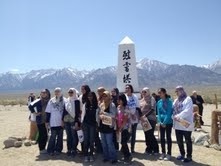
John Asanuma was 11 years old when President Franklin D. Roosevelt signed Executive Order 9066, paving the path for mass imprisonment of Japanese Americans after Pearl Harbor. The Los Angeles native, and his parents were sent to Manzanar in 1942–one of the largest camps housing more than 120,000 Japanese Americans during World War II. The desert weather at the camp, located near Death Valley, brought in scorching summers and chilling winters. When it snowed, John and his friends built makeshift snow slides. During the other seasons, they played softball with sticks and pine cones. Three years later, officials closed the camp, and John and his parents moved to Fresno.
“When I left camp, the first thing I did was kiss the street,” he said. “I felt my sense of freedom again.”
]

Asanuma revisited the camp on Saturday at the yearly “Manzanar Pilgrimage“, a day-long program dedicated to remembering that dark era in American history and the lessons that came out of it. The annual program draws approximately 1,000 participants; among them was a group of about 50 Muslim Americans, hosted by the Anaheim-based chapter of the Council on American Islamic Relations (CAIR).
“It's important for Muslim Americans to understand how another group struggled,” said CAIR spokesperson Munira Syeda. “And what happens if people remain silent and don't stand up for the rights our Constitution grants us.”
Munira said that members of the Japanese-American community, like Kathy Masaoaka, were among the first groups to reach out to Muslim Americans post-9/11 attacks. Masaoka fought for government reparations for the Japanese American community in the 1980s, and now she co-chairs Nikkei for Civil Rights and Redress. She said she understood the importance of reaching out to Muslims after 9/11.
“When I heard Muslim and Arab-Americans talking about how afraid they were after 9/11, that's when I understood how our community felt for the first time,” she said. “I didn't understand it before – feeling that fear just because of the way you looked.”
The relationship between both groups culminated in programs like Bridging Communities (a learning exchange between Japanese-American and Muslim-American students) and a yearly trip to Manzanar. Around 50 Muslim Americans attended the pilgrimage this year. Some of them said they barely learned about the internment camps in high school, and they wanted to find out more about the history.
Among them was Kashif Ghani, who leads weekend religious studies classes at a Mission Viejo mosque. While he said he can't compare the Japanese-American experience to that of Muslims in America, he felt empowered by the trip.
“After 9/11, I didn't want to get involved,” 25-year-old Kashif said. “I wanted to avoid confrontation. Coming here and seeing how Japanese-Americans have confronted the government inspired me to not feel ashamed. We didn't do anything wrong, and we shouldn't feel afraid to say anything against the government or bad policies.”
Kashif convinced most of his students from the mosque to attend this year's program. During the day, they walked around the site, prayed in an interfaith memorial service for those who died at Manzanar, and participated in an evening breakout session where former incarcerees (or their children) shared their experiences as internees at Manzanar.
In one of the discussion groups, Don Hosokawa of Huntington Beach said his parents were interned at Manzanar, and two of his sisters were born there. At the camp, his father used to sneak out with friends at night to fish at streams nearby; a documentary called Manzanar Fishing Club was later made about the fishermen. As Hosokawa shared his parents' story, other group members reflected on discrimination in general, including Omar Jarrad, a Muslim-American of Palestinian descent. The eighth grader at Las Flores Middle School in Rancho Santa Margarita, said that some of his fellow peers repeatedly taunt him at school by calling him names like “camel jockey” and “terrorist.”
“Hey, don't feel bad,” Don said to Omar. “We went through this stuff, so just know that you're not alone.”
Jarrad said he learned a lot about the struggles of Japanese Americans at the camp site; the experience empowered him. “It made me believe in myself,” he said. “And I'm not going to listen to those who make fun of me anymore. I don't feel alone anymore.”
Other Muslim-Americans found meaning in the trip, as well. Hanan Seirafi, an economics major at UC Irvine, wanted to visit the site to learn more about the firsthand experiences of Japanese American internees.
“The fact that fear can do this to innocent people is shocking,” she said. “As Muslims today, we're being analyzed through a scope of fear so it draws a connection. It's hard not to make that connection.”

